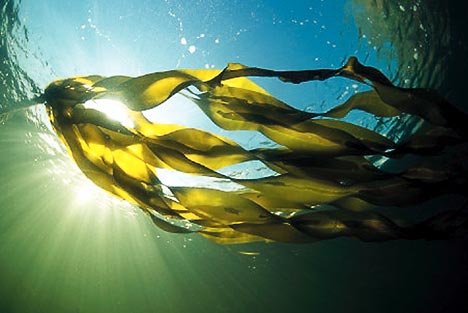When I was growing up, my younger sister loved to watch Sigmund and the Sea Monsters. The TV show aired on Saturday mornings and ran between 1973 and 1975. I don’t remember liking it. At the ripe age of 5, I thought it was too goofy. I preferred cheesy rerun shows like Gilligan’s Island and Family Affair. At the time, I also liked the child actor’s more clean-cut look in Family Affair…

…as opposed to his wilder look as a pre-teen.

Fast-forward forty-plus years and I now appreciate both a good ‘fro AND seaweeds of the non-goofy kind.
Seaweeds – more aptly described as “sea vegetables” – have been used for thousands of years for longevity, disease prevention and beauty enhancements. Throughout the Pacific Northwest, indigenous peoples ate local nori seaweed. It is a staple in Asian diet and cuisine and in Ireland it’s making a comeback as the latest hip “superfood.”

Here are 10 fun facts to know about seaweeds:
- ALL of them are edible, although some taste better than others.
- Like many plants, they are seasonal!
- Many contain all 20 essential amino acids, thus furnishing complete proteins.
- Ounce per ounce, seaweed is higher in vitamins and minerals than any other class of food.
- They average seven times more calcium per 100 g serving than cow’s milk!
- Seaweeds provide ALL of the trace elements our bodies need in the correct balance.
- Seaweeds are actually not plants, but algae. (I know, that doesn’t strengthen the case I want to make for eating them.)
- They cool and soothe burns.
- They make amazing compost.
- There are classified by color: red, brown, green, blue-green and yellow-green.
The color depends in part on the light available. Greens are in the upper tidal zone closer to the shore,
while reds are sub-tidal (never uncovered, even at low tide).
According to The Essential Herbal Magazine:
“They have the highest mineral content of any food that you can eat. They also help to rid the body of toxins and may help prevent cancer. Seaweed is an excellent source of calcium, iodine, essential for thyroid health, folic acid and magnesium, which protect the cardiovascular system, and a host of other nutrients. They are also high in ligans, plant compounds that protect against cancer and help relieve menopausal symptoms, and fucans, which can reduce inflammation. If you have stress and anxiety issues, try seaweed for the B vitamins pantothenic acid and riboflavin, often depleted with daily tension.”
In addition, the nutritional composition of seaweed helps:
-
- Lower cholesterol
- Strengthen bones and teeth
- Stimulate and improve blood and lymph circulation
- Nourish and detoxify the skin
- Strengthen the immune system
- Correct mineral deficiencies
- Improve nerve transmission
- Stabilize blood pressure
- Strengthen digestion
- Reduce tension
- Relieve muscle pain and fatigue
Clearly, seaweeds are nutritional powerhouses. If your only experience eating seaweed has been in miso soup, sushi or strong-tasting seaweed salad, rest assured there are many other ways to prepare seaweed that cut down on the “slime” factor. Perhaps the easiest way to add seaweed to your diet is to combine dried kelp and sesame seeds, blend until fine, and replace the salt on your table with it. You get the salt flavor with all the benefits of the seaweed and none of the drawbacks of salt. We use this blend on eggs, rice, vegetables, you name it – all with great results.
My ethnobotany instructor Karen Magnuson refers to seaweeds as the “gift from the sea” and says that if there is a fountain of youth, it is at the intertidal zone. She has many delectable recipes for different varieties of seaweed. Her recipe for coastal baked oatmeal with kelp will make you a believer in both oatmeal and seaweed!
Coastal Baked Oatmeal by Karen Magnuson
2 cups rolled oats
1/2 c. softened coconut oil
1/4 c. brown sugar
1/2 c. ground kelp fronds or 2 tsp. kelp powder
1 T. baking powder
1 egg
3/4 cup milk or milk substitute
1 tsp. vanilla
Nuts, raisins, blueberries, currants, dried cranberries as desired.
Blend wet ingredients thoroughly, then add dry ingredients and stir until just mixed. Pour into an oiled 5×7 loaf pan. Bake 35 minutes at 350 degrees F. This recipe doubles and triples well and is perfect for family gatherings year ’round.
Note 1: If you have never had baked oatmeal, it tastes completely different from oatmeal cooked on the stovetop! I have been known to serve this baked oatmeal at any time of day. It is especially scrumptious with peaches and raspberries gently simmered in good-quality maple syrup. If you fall in the “Seaweed? Yuck – no way!” category, this is a good way to sneak in your sea veggies. You can’t even taste it!
Note 2: You want to use good quality, unpolluted seaweed. If you’re not harvesting your own (subject of an upcoming post), Karen recommends ordering from the Mendocino Sea Vegetable Company and Maine Coast Sea Vegetables among others. I also buy kelp powder from Mountain Rose Herbs. This powdered form is much stronger than grinding your own dried seaweed. If you add 1/2 c. of this stuff, you’ll definitely taste it in the oatmeal!
